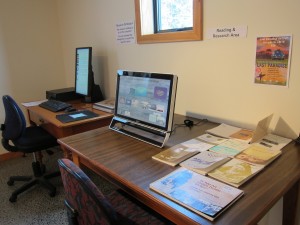 Seaside town goes digital
Seaside town goes digital
Te Papa National Services asked Roslyn Miles from the Raglan and District Museum about digitising the museum’s collection, and being one of the first museums to have part of their collection on the NZMuseums website.
Tell us about the museum
The Raglan and Districts Museum is a small museum which holds the collections of a seaside town in the Waikato area of New Zealand. Staffed by volunteers and one part-time employee on project work, the museum is only open to the public for a few hours over weekends. The history of this area is vast, and spans from early Māori civilization through to Missionary and Settler activity from the 1830s and beyond. You can read more about this history on our NZMuseums profile page.
Tell us about the project
The NZMuseums website project coincided with our own journey of digitising and cataloguing all of our artefacts into PastPerfect 4.0. Our initial reaction was that it was going to be a nightmare because we realised we needed a lot more information to complete the excel spreadsheet. But we have found the NZMuseums website to be very useful, and a great way to display our collections to a much wider audience.
Who was in the team involved?
It consisted mainly myself and Rodger Gallagher (on the Museum Society). I was employed for 30 hours a week, originally just to catalogue artefacts onto PastPerfect 4.0 as part of the larger project of building the new Raglan Museum. Simon Kearns and Steve Soanes also assisted with researching the items.
How did you decide what to digitise?
By using the NZMuseums website as motivation, we narrowed our selection down to 100 artefacts, took the digital photographs, and researched what we could in the time available. We chose anything that was interesting to others, or about which we could verify a history or story. I didn’t want to include anything that was a bit iffy. It was difficult to foresee how the information would look online, but thanks to the patience and guidance of the people on the project team, we were able to complete the project within the deadline.
Who and how did you research the objects?
I used a series of books on Raglan history by R.T. Vernon, plus any previously recorded notes in an old accessions book to research the histories of the items held in our collection. A recent exhibition run by Rodger and Simon of historical photographs of Raglan (held by the museum) provided invaluable information. Rodger, Simon and Steve were also helpful as they have lived in the Raglan area for many years and are fascinated with its history.
Who photographed the items?
I photographed all the items for the NZMuseums website. Later on, I went to the Photography for the web workshop held at Waikato Museum and run by National Services Te Paerangi. I found the workshop really interesting, and had a few mysteries cleared up.
How long did the project take?
It took about three months, from June to September 2008. This included choosing and photographing objects, setting up the spreadsheet, and tweaking the final copy before the final launch date.
What was the biggest barrier?
For me, it was the timing, because we were right at the beginning of getting the museum up and running in Past Perfect 4.0. Any other museum would find it easier, I imagine, by selecting from its already functioning archives – I had barely started, so there weren’t many complete artefacts in the history collection from which to choose.
What was the best bit?
I loved the way that putting items up on the website gave them a new life. In our current museum it’s impossible to give the items the context they need, so taking them off the shelves and highlighting them online has been an excellent way to place the artefacts back into their history. Also, just using all the different skills to get the work done was fun enough for me!
What have the benefits been?
Local people have shown more interest since seeing their museum on the Internet, and tourists are able to access it ahead of their stay in our seaside town. Researchers interested in topics specific to our area also find it useful. I particularly like the interactive nature of it, as I have had people ask questions about the objects, and this can lead to a deeper understanding of an artefact, or recognition of its worth, or reveal an ancestral connection. Now, over time, we will be able to add further artefacts, and this will more completely tell the stories of Raglan/Whaingaroa area and its people.
